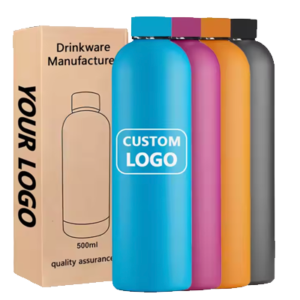Why use aluminum foil for vacuum insulated water bottles?
When we think of vacuum-insulated bottles, most of us picture double-wall stainless steel, a sleek exterior, and the promise of hot drinks that stay hot (or cold drinks that stay refreshingly cold). But what actually keeps your coffee warm for hours? Sure, the vacuum between the inner and outer walls is the main player—but it’s not working alone.
In fact, there’s a little-known secret inside many high-performance insulated bottles: aluminum foil.
Yes, we’re talking about the same shiny material you use in your kitchen—but here, it’s doing much more than wrapping leftovers. Inside a vacuum insulated bottle, aluminum foil plays a smart supporting role by helping to reduce heat loss through radiation, something the vacuum alone can’t fully block.
Think of it as a mirror for heat. While the vacuum stops heat from traveling by conduction and convection, aluminum foil reflects radiant heat back toward the center of the bottle, helping to keep the temperature stable for longer.
In this article, we’ll dive deeper into how this thin layer of foil makes a big difference—and why water bottle manufacturers are using it to boost insulation performance.
Table of Contents
ToggleHow Aluminum Foil Works Inside the Bottle
To understand why aluminum foil is used in vacuum insulated bottles, let’s first break down how heat escapes.
There are three ways heat moves: conduction, convection, and radiation.
The vacuum between the bottle’s inner and outer walls does a great job of stopping conduction and convection—that’s its main job.
But radiation is trickier. It’s the invisible energy that travels in waves, kind of like how the sun warms your face even on a cold day. And unfortunately, even in a vacuum, radiant heat can still sneak through.
That’s where aluminum foil comes in.
Aluminum is a highly reflective material. When placed inside the vacuum layer—usually wrapped around the inner wall—it reflects radiant heat right back toward the liquid inside the bottle, instead of letting it escape. It works like a thermal mirror, bouncing heat waves back where they came from.
The result? Your drink stays hot (or cold) longer, without adding any bulk or complex materials. It’s a simple trick that brings a noticeable boost to insulation performance—especially helpful in bottles used for long hours or in outdoor conditions.
And don’t worry—you won’t see or feel the foil. It’s completely hidden within the vacuum layer, quietly doing its job every time you sip your tea or coffee.
How Is Aluminum Foil Added to the Bottle?
Now that we know what aluminum foil does inside a vacuum insulated bottle, you might be wondering:
“How do manufacturers actually get it in there?”
It’s not as simple as just stuffing a piece of foil between two metal walls. The process has to be precise—after all, we’re dealing with vacuum technology and temperature-sensitive materials. Here’s how it works behind the scenes:
Step 1: Cut and shape the foil
First, the aluminum foil is cut into the exact size and shape needed to fit the vacuum layer. It has to wrap neatly around the inner wall, without crumpling or overlapping too much. The foil needs to sit flat and tight to do its job well.
Step 2: Positioning before vacuum sealing
The foil is placed around the inner stainless steel liner before the outer shell is sealed and the vacuum is created. This is a critical moment. Once the two layers are joined and the vacuum is pumped, there’s no going back. The foil has to be perfectly in place beforehand.
Step 3: Sealing and vacuuming
After the foil is positioned, the inner and outer walls are welded together at the top. Then, the air between the two layers is removed using a vacuum pump. The final result is a sealed space with no air, a reflective aluminum layer, and a structure that’s ready to lock in heat.
This step requires strict quality control. If the foil shifts even slightly, or if the seal isn’t tight, it could impact both the insulation and the durability of the bottle. That’s why experienced manufacturers invest in automated positioning systems and vacuum testing to make sure every bottle meets performance standards.
In short, while the foil might be invisible to the end user, it’s handled with care and precision during production—just another example of how much thought goes into making a bottle that keeps your drink at the perfect temperature.
Aluminum Foil vs. Copper Coating – What’s the Difference?
Aluminum foil isn’t the only trick up a bottle manufacturer’s sleeve. Another popular method for boosting heat retention is copper coating—specifically, applying a thin copper layer to the outside of the inner wall. So how does this compare to using aluminum foil?
Reflective Power
Both aluminum and copper are excellent at reflecting radiant heat. However, copper has a slightly higher thermal reflectivity, which means it can bounce back more heat radiation. That said, aluminum still does a very effective job—especially when used in a sealed vacuum environment.
Placement and Process
Copper coating is usually sprayed or electroplated directly onto the inner liner’s exterior surface. It requires extra equipment, and the process is more complex and time-consuming. Aluminum foil, on the other hand, is simpler and easier to apply, often requiring only accurate placement and proper sealing during assembly.
Cost and Application
Here’s where aluminum really shines. Copper is more expensive, both as a material and in terms of processing. That’s why copper coatings are usually found in premium or high-end bottles, while aluminum foil offers a cost-effective alternative with nearly comparable performance. For most users, the difference in insulation performance is minimal—but the cost difference can be significant.
Flexibility in Design
Copper coatings are usually fixed and permanent, while aluminum foil can be added or omitted depending on the model or insulation grade. This gives manufacturers more flexibility in product design and pricing across different market segments.
Copper might be the gold standard in insulation enhancement, but aluminum foil offers a smart balance between performance, cost, and simplicity. For brands looking to deliver reliable heat retention without raising the price tag, aluminum foil is a solid choice.
How We Ensure Quality in Aluminum Foil Insulation
Using aluminum foil to enhance insulation sounds simple—but making it work consistently in mass production requires precision, experience, and a serious commitment to quality.
At our factory, we start by choosing high-purity aluminum foil with excellent reflective properties. Not all foil is created equal—lower-grade options can wrinkle, tear easily, or lose effectiveness over time. That’s why we work only with trusted suppliers and test every batch before it enters the production line.
Once the foil arrives, it’s shaped and positioned with great care. It needs to wrap tightly and evenly around the inner stainless steel liner. If it’s too loose, it may shift or fold during sealing. Too tight, and it can crumple or create air pockets. We use customized placement tools to ensure the foil sits flush against the liner, with minimal variation across units.
Timing is critical. The foil must be in perfect position before we move on to the vacuum-sealing process. Once the inner and outer walls are welded together and the vacuum is created, there’s no way to adjust or reposition the foil. That’s why our production line includes real-time monitoring and alignment checks at every stage. After sealing, every bottle goes through vacuum integrity testing to make sure the insulation layer is fully sealed and performing as expected.
But we don’t stop there. Our quality team routinely conducts heat retention tests, comparing different models and configurations—including bottles with and without aluminum foil. The results consistently show that foil-lined bottles offer improved temperature stability, especially over extended periods.
And we’re always looking for ways to do better. From experimenting with foil thickness to combining foil with other technologies like copper coating, our R&D team keeps pushing the boundaries of performance. Because when it comes to insulation, small details can make a big difference—and we’re here to make sure those details are always working in your favor.
The Little Layer That Makes a Big Difference
When you pick up a vacuum insulated bottle that keeps your drink warm for hours, you’re holding more than just stainless steel and a vacuum seal—you’re holding the result of carefully engineered details working together behind the scenes. Aluminum foil may be thin and hidden from view, but it plays a powerful role in reducing heat loss and boosting insulation performance.
For water bottle manufacturers like us, it’s one of the smart, cost-effective techniques that help us deliver real value without adding unnecessary complexity. Whether you’re sourcing products for your brand or developing custom bottles for a gift or promotional program, understanding these technical details can help you make better choices—and give your customers a better experience.
If you’re looking to customize high-performance vacuum bottles and want advice on insulation solutions—aluminum foil, copper coating, both or neither—we’re here to help. Let’s create something that not only looks good, but keeps the heat exactly where it should be.
–> Contact us


